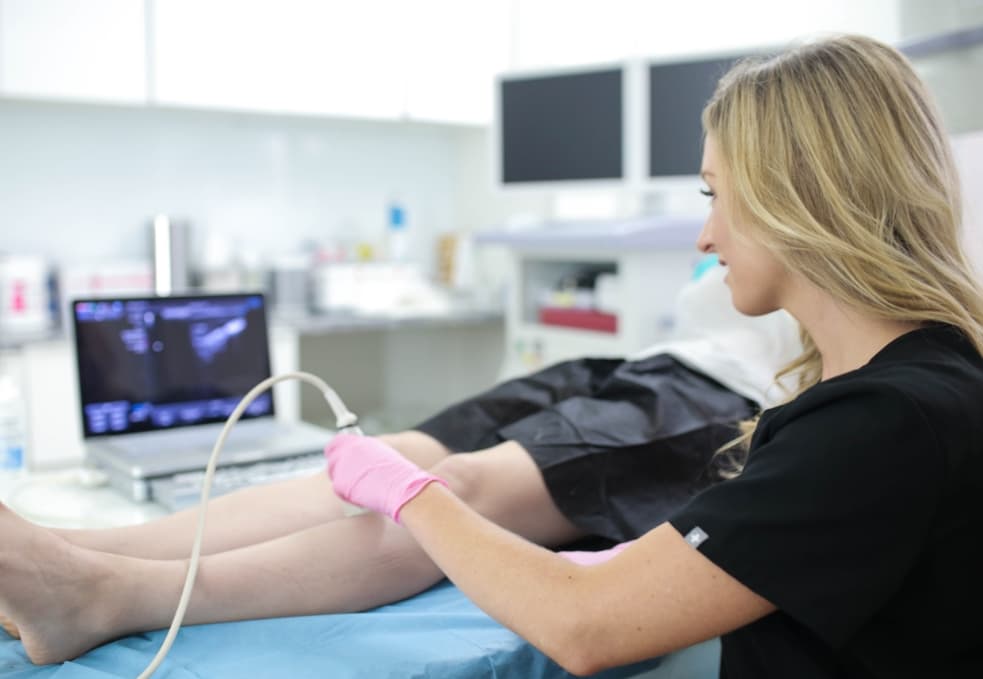How do you know if you have vein problems?
Patients usually only contact vein doctors when they notice spider veins or varicose veins. But patients who consult vein doctors are often told that they’ve had an underlying vein disease for several weeks or even months. That’s because spider veins and varicose veins are usually symptomatic of a circulatory disorder known as chronic venous insufficiency, and they appear in the later stages of the disease. The initial signs and symptoms of vein disease are fairly mild and benign, often misattributed to aging or exhaustion.
Chronic venous insufficiency is a circulatory disorder caused by the collapse of vein valves. In healthy veins, the valves act as one-way doors to ensure blood flows towards the heart and not backward because of gravity. When your vein valves collapse, blood flows backward due to gravity and accumulates in the leg veins and blood vessels, leading to vascular dilation and the eventual formation of spider veins and varicose veins. But before you notice spider veins and varicose veins, you may notice several other vein problems.
Below, we describe some of the most common spider vein and varicose vein problems.
Leg Heaviness
Leg heaviness is one of the first warning signs of vein disease. Most people suffer from heavy and tired legs occasionally because of overexertion, underuse, increased physical activities, and other normal reasons. But if you have persistent leg heaviness, especially at night or after long periods of sitting or standing, you may have vein disease.
Frequent Leg Cramps
Most people experience leg cramps occasionally. Leg cramps are sudden, involuntary muscle contractions in the legs, which can lead to increased leg pain. You may experience leg cramps because of strenuous workouts, lack of muscle use, dehydration, and numerous other factors. But if the symptoms of leg cramps worsen at night, you may have vein disease.
Restless Leg Syndrome
Restless leg syndrome is a condition where you have an irresistible urge to shake and move your legs, especially after long periods of sitting or standing still or at night. If you have persistent restless leg syndrome, especially at night, there’s a strong chance you have accumulated blood in your leg veins because of venous insufficiency.
Leg Swelling
Leg swelling is a condition wherein fluid buildup in your ankles or feet makes your legs look swollen and heavy. You may experience leg swelling for several factors, such as cardiovascular condition, obesity, and more. But if leg swelling usually worsens at night or after long periods of sitting or standing still, you may have venous insufficiency.
Spider Veins
Spider veins are dense clusters of damaged blood vessels that appear just underneath the skin’s surface, usually looking like a mass of spider webs. They’re essentially damaged blood vessels with excess blood accumulation or broken capillaries on the legs. The presence of spider veins usually indicates chronic venous insufficiency.
Varicose Veins
Varicose veins are dense masses of twisted, tangled, knotted, rope-like blood vessels that bulge out of the skin’s surface. They often look like ropy blood vessels or tree trunks. The presence of varicose veins indicates that considerable blood has accumulated in the leg veins, indicating advanced chronic venous insufficiency.
Skin Discoloration
Skin discoloration is one of the advanced complications of chronic venous insufficiency. In its advanced stage, vein disease prevents proper blood circulation in your legs, which makes your legs look pale and discolored. You may also notice rust-colored, reddish, leathery patches on your skin because of broken blood cells.
Leg Ulcers
Leg ulceration is a condition marked by non-healing wounds on your legs. When you suffer a minor injury or wound, the blood flow in your legs promotes healing and closes the wound. Venous insufficiency prevents healthy blood circulation in the leg veins, so minor injuries, scratches, and wounds can’t heal properly, leading to ulceration on the legs.
Deep Vein Thrombosis (DVT)
Deep vein thrombosis (DVT) is a medical condition marked by the formation of blood clots in leg veins. The accumulated blood in your leg veins may clot and harden. When these blood clots break away, they may travel to the lungs and induce a potentially fatal pulmonary embolism.
When should I be worried about veins?
You should be concerned about your vascular health if you notice any of the signs or symptoms of vein disease. Venous insufficiency is a chronic condition, so you must seek treatment promptly. The longer you delay vein treatment, the worse your symptoms will become.
What can cause vein problems?
Chronic venous insufficiency is the primary root cause of most vein problems. When your vein valves collapse or malfunction, blood flows backward and accumulates in the leg veins, eventually leading to numerous vein problems.
How do you test your veins?
We use duplex ultrasound scans to test your veins. During a duplex ultrasound test, our vein doctors use handheld devices to generate ultrasound energy, which reveals the direction of blood flow in your leg veins. Our vein doctors study the direction of blood flow to determine if you have chronic venous insufficiency and identify the damaged veins.
Is walking good for varicose veins?
Walking is good for vascular health and varicose veins. When you walk, your calves push some of the accumulated blood towards the heart, alleviating some of the worst symptoms of vein disease. Walking also improves blood circulation. But walking won’t treat chronic venous insufficiency — it will only provide temporary relief. The only way to treat varicose veins and vein disease is through minimally invasive vein treatments in Long Island.
Long Island Vein Treatment is a group of state-of-the-art spider vein and varicose vein treatment centers in West Islip, Jericho, and Hampton Bays. If you notice the signs and symptoms of vein disease and other vein problems, please schedule your vein treatment in Long Island today.
